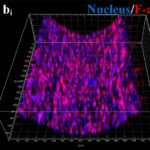Paper, Projection-based 3D Bioprinting
“Projection-based 3D bioprinting can be summarized as a surface-to-entity forming method. As the printing process begins, the platform firstly goes down and submerges under the liquid material surface, leaving a thin gap between the tank bottoms. This gap, when filled with materials, has the same thickness with each digital slice. Then, the projector sends the image of the first slice through the transparent bottom, illuminating the materials within the image boundary. In a short period, the photocurable liquid material crosslinks and turns into gel state. Subsequently, the platform rises to leave another gap between the first print and the tank bottom. Then, the image of the next slice is projected. The special design of the hydrophobic bottom guarantees that the new print will stick to the platform or the former slice. Finally, as the cycle continues, the whole model will be printed layer by layer. Obviously, with the same process parameters, the printing duration is only determined by the height of the models, and it has nothing to do with the area of each image. Therefore, the PBP method is particularly good at manufacturing large quantities of consistent sample copies.”
Learn about our two Decals!
 Click here to find out more about our Fall Bioinspired Design Decal and our Spring Bioinspired Design in Action Decal – ALL MAJORS are welcome.
Click here to find out more about our Fall Bioinspired Design Decal and our Spring Bioinspired Design in Action Decal – ALL MAJORS are welcome.Berkeley BioDesign Community
 Click here to learn about the BioD: Bio-Inspired Design @ Berkeley student organization or here to signup for more info.
Click here to learn about the BioD: Bio-Inspired Design @ Berkeley student organization or here to signup for more info.Search
Student Login




I imagine that the neurological circuits underlying these processes are governed by both 2d spacing maps with their brains as…
to reduce the impact of car accidents, it may be possible to study the force diverting physics of cockroaches to…
you see this type of head-bobbing stability in many avian creatures related to pigeons like chickens. the head ability to…
not like they taught horses how to run! this is an example of convergent evolution where both sea creatures and…
The brain functions in a similar way with neuronal connections. our brains are able to utilize the multiplicity of connections…